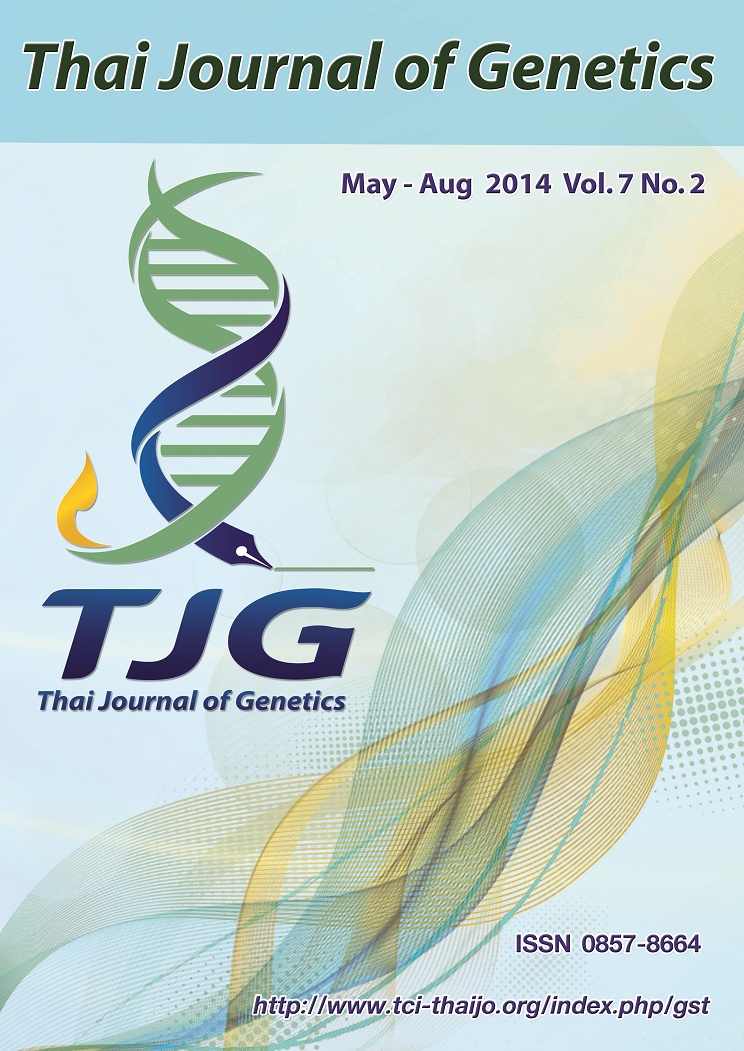ความแตกต่างทางพันธุกรรมระหว่างข้าวไทยที่ไวต่อช่วงแสงและไม่ไวต่อช่วงแสง (Genetic differences between photoperiod-sensitive and non-photoperiod-sensitive Thai rice varieties)
DOI:
https://doi.org/10.14456/tjg.2014.4Keywords:
ข้าว, ยีน Hd1, ไวแสงAbstract
ยีน Hd1 เป็นยีนหลักที่ควบคุมการตอบสนองต่อช่วงแสงของข้าว การศึกษาในครั้งนี้มีวัตถุประสงค์เพื่อศึกษาลำดับเบสของยีน Hd1 ในข้าวไทยที่ไวต่อช่วงแสง ได้แก่ ขาวตาแห้ง 17, เหนียวสันป่าตอง, กข 6, และ กข 15 และข้าวที่ไม่ไวต่อช่วงแสง ได้แก่ พิษณุโลก 2, แพร่ 1, กข 21 และ สุรินทร์ 1 เพื่อให้เข้าใจกลไกการตอบสนองต่อช่วงแสงของข้าวไทยมากขึ้น จากการศึกษาลำดับเบสบริเวณโพรโมเตอร์ของยีน Hd1 ในข้าวทั้ง 8 พันธุ์ พบการแทนที่เบส 2 ตำแหน่ง และความผันแปรของจำนวนซ้ำของเบสไซโทซีน 1 ตำแหน่ง (20-25 คู่เบส) แต่ความผันแปรของเบสบริเวณโพรโมเตอร์น่าจะไม่เกี่ยวข้องกับการตอบสนองต่อช่วงแสงของข้าวที่ศึกษา เนื่องจากบริเวณที่มีความผันแปรไม่ใช่ตำแหน่งจับของทรานสคริปชัน แฟคเตอร์ หรือไม่มีความแตกต่างระหว่างข้าวที่ไวต่อช่วงแสงและไม่ไวต่อช่วงแสง ลำดับเบสบริเวณเอกซอน 1 พบการแทนที่เบส 1 ตำแหน่ง แต่ไม่ทำให้เกิดการเปลี่ยนแปลงชนิดของกรดอะมิโน ลำดับเบสบริเวณเอกซอน 2 พบการขาดหายไปของดีเอ็นเอความยาว 4 คู่เบส ในข้าวที่ไม่ไวต่อช่วงแสงซึ่งทำให้เกิดการเลื่อนของรหัสพันธุกรรมและทำให้กรดอะมิโนโนบริเวณ nuclear localization signal (CCT motif) ในข้าวที่ไม่ไวต่อช่วงแสงเปลี่ยนไป ซึ่งอาจทำให้ยีน Hd1 สูญเสียการทำงานและทำให้ข้าวไม่ตอบสนองต่อช่วงแสง
Hd1 is a major gene controlling response to photoperiod in rice. This study aimed to investigate DNA sequences of Hd1 gene in Thai rice including photoperiod-sensitive varieties (Khaotahhaeng 17, Neawsunpatong, RD 6 and RD 15) and non- photoperiod-sensitive varieties (Phitsanulok 2, Phrae 1, RD 21 and Surin 1) to deepen understanding in photoperiod response mechanism in Thai rice. Among eight rice varieties, two base substitutions and length polymorphism of poly C (20-25 bp) were found in the promoter region. However, these variations may be not responsible for photoperiod sensitivity in Thai rice because the variable positions were not the transcription factor binding sites or were not different between photoperiod-sensitive and non-photoperiod-sensitive varieties. One base pair substitution was detected in the first exon but did not alter amino acid residue. In the second exon, deletion of four base pairs was found only in non-photoperiod-sensitive varieties. The deletion caused a frameshift in DNA sequences and changes in amino acid residues in the nuclear localization signal (CCT motif) and may therefore result in a loss of function of Hd1 gene in the non-photoperiod-sensitive varieties.
References
กรมวิชาการเกษตร ( 2546) ข้าวและธัญพืชเมืองหนาวพันธุ์ดี 30 ปี กรมวิชาการเกษตร พิมพ์ที่ชุมนุมสหกรณ์การเกษตรแห่งประเทศไทย กรุงเทพฯ
Artimo P, Jonnalagedda M, Arnold K, Baratin D, Csardi G, de Castro E, Duvaud S, Flegel V, Fortier A, Gasteiger E et al. (2012) ExPASy: SIB bioinformatics resource portal. Nucleic Acids Res 40: W597–W603.
Ebana K, Shibaya T, Wu JZ, Matsubara K, Kanamori H, Yamane H, Yamanouchi U, Mizubayashi T, Kono I, Shomura A et al. (2011) Uncovering of major genetic factors generating naturally occurring variation in heading date among Asian rice cultivars. Theor Appl Genet 122: 1199–1210.
Hall TA (1999) BioEdit: A user-friendly biological sequence alignment editor and analysis program for Windows 95/98/NT. Nucleic Acids Symp Ser 41: 95–98.
Higo K, Ugawa Y, Iwamoto M and Korenaga T (1999) Plant cis-acting regulatory DNA elements (PLACE) database. Nucleic Acids Res 27: 297–300.
Marchler-Bauer A , Lu SN , Anderson JB, Chitsaz F, Derbyshire MK , DeWeese-Scott C, Fong, JH, Geer, LY, Geer RC, Gonzales NR et al. (2011) CDD: a conserved domain database for the functional annotation of proteins. Nucleic Acids Res 39: D225–D229.
McWilliam H, Li W, Uludag M, Squizzato S, Park YM, Buso N, Cowley AP, Lopez R (2013) Analysis tool web services from the EMBL-EBI. Nucleic Acids Res 41: W597–W600.
Prestridge DS (1991) SIGNAL SCAN: A computer program that scans DNA sequences for eukaryotic transcriptional elements. CABIOS 7: 203–206.
R Development Coe Team (2013) R: A language and environment for statistical computing. R Foundation for Statistical Computing, Vienna, Austria. ISBN 3-900051-07-0.
Roongsattham P, Pongtongkam P, Thongpan A, Kaveeta L, Harinasut P, Peyachoknagul S (2006) Hd1, Hd3a, and Hd6 Genes: Possible DNA methylation roles in photoperiod sensitive gene regulation of rice KDML 105 (Oryza sativa L.). Kasetsart J (Nat Sci) 40: 462–471.
Solovyev VV, Salamov AA (1997) The Gene-Finder computer tools for analysis of human and model organisms genome sequences. In: Rawling C, Clark D, Altman R, Hunter L, Lengauer T, Wodak S (eds) Proceedings of the Fifth International Conference on Intelligent Systems for Molecular Biology. AAAI Press, Halkidiki, Greece, pp 294–302.
Solovyev VV (2001) Statistical approaches in Eukaryotic gene prediction. In: Balding D, Bishop M, Cannings C (eds) Handbook of Statistical Genetics. John Wiley & Sons, Ltd., pp 83–127.
Solovyev VV, Shahmuradov IA (2003) PromH: Promoters identification using orthologous genomic sequences. Nucleic Acids Res 31: 3540–3545.
Takahashi Y, Teshima KM, Yokoi S, Innan H, Shimamoto K (2009) Variations in Hd1 proteins, Hd3a promoters, and Ehd1 expression levels contribute to diversity of flowering time in cultivated rice . Proc Natl Acad Sci USA 106: 4555–4560.
Yano M, Katayose Y, Ashikari M, Yamanouchi U, Monna L, Fuse T, Baba T, Yamamoto K, Umehara Y, Nagamura Y et al. (2000) Hd1, a major photoperiod sensitivity quantitative trait locus in rice, is closely related to the Arabidopsis flowering time gene CONSTANS. Plant Cell 12: 2473–2484.
http://www.ebi.ac.uk/Tools/msa/clustalo/ (April 2014).



